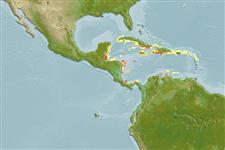Classification / Names
Nombres comunes | Sinónimos | Catalog of Fishes(Género, Especie) | ITIS | CoL | WoRMS | Cloffa
>
Gobiesociformes (Clingfishes) >
Gobiesocidae (Clingfishes and singleslits) > Gobiesocinae
Etymology: Tomicodon: Greek, tomikos, -e, -on = that is useful for cutting (Ref. 45335); lavettsmithi: Named in honor of C. Lavett Smith, Emeritus Curator of Ichthyology at AMNH, in recognition of his many contributions to the systematics and behavioral ecology of Caribbean reef fishes and leadership of the Pelican Cays fish survey (Ref. 50106).
Environment: milieu / climate zone / depth range / distribution range
Ecología
marino demersal; rango de profundidad 0 - 1 m (Ref. 50106). Deep-water
Western Central Atlantic: Belize.
Tamaño / Peso / Age
Maturity: Lm ? range ? - ? cm
Max length : 2.7 cm SL macho / no sexado; (Ref. 50106)
Short description
Claves de identificación | Morfología | Morfometría
Radios blandos dorsales (total) : 6 - 7; Radios blandos anales: 6 - 7; Vértebra: 29 - 31.
Facultative air-breathing in the genus (Ref. 126274)
Life cycle and mating behavior
Maturities | Reproducción | Spawnings | Egg(s) | Fecundities | Larva
Williams, J.T. and J.C. Tyler, 2003. Revision of the western Atlantic clingfishes of the genus Tomicodon (Gobiesocidae), with descriptions of five new species. Smithson. Contrib. Zool. 621:1-26. (Ref. 50106)
IUCN Red List Status (Ref. 130435)
Threat to humans
Harmless
Human uses
Herramientas
Special reports
Download XML
Fuentes de Internet
Estimates based on models
Phylogenetic diversity index (Ref.
82804): PD
50 = 0.5000 [Uniqueness, from 0.5 = low to 2.0 = high].
Bayesian length-weight: a=0.00617 (0.00250 - 0.01521), b=3.15 (2.94 - 3.36), in cm total length, based on LWR estimates for this (Sub)family-body shape (Ref.
93245).
Nivel trófico (Ref.
69278): 3.1 ±0.4 se; based on size and trophs of closest relatives
Resiliencia (Ref.
120179): Alto, población duplicada en un tiempo mínimo inferior a 15 meses (Preliminary K or Fecundity.).
Fishing Vulnerability (Ref.
59153): Low vulnerability (10 of 100).
